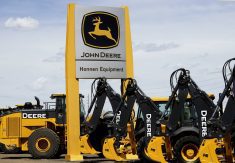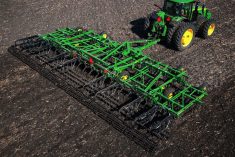A court ruling strengthening Deere and Co.’s claim to the use of green and yellow on farm equipment in the U.S. centres on how likely farmers are to believe they’re looking at a Deere or Deere-approved product.
In a 107-page ruling in October, following a five-day trial in June, the U.S. District Court at Paducah, Ky. granted Deere an injunction blocking South Dakota-based shortline manufacturer Fimco, Inc. from making and/or selling green-and-yellow sprayers and other trailed or wheeled farm equipment.
Deere, whose John Deere farm equipment is nearly all painted in a green and yellow colour scheme, and which is the only maker of green-and-yellow tractors in the U.S., also sought an injunction blocking Fimco from making green sprayers with yellow tanks.
Read Also

Huge crops in South America says analyst
Although there’s a debate over the size of the South American soybean crop, there’s little doubt that it will be an enormous one, said consultant Michael Cordonnier of Soybean and Corn Advisor in Hinsdale, Ill.
Deere estimated in court that over the years it has sent cease-and-desist requests to about 40 companies offering products with green-and-yellow colour schemes. All but three, Fimco included, “agreed to stop,” the company said. Deere today also has three U.S. trademarks for its equipment lines’ colour scheme.
Fimco and Deere stipulated to the fact that the green-and-yellow colour schemes they used were “indistinguishable” from each other on equipment in the field.
Fimco’s main business is in lawn and garden sprayers and other lawn and garden tractor attachments, sold typically in a white, red and black colour scheme. Its other business line is its trailed (pull-type) agricultural sprayers and trailed liquid nutrient applicators — which, until now, have sported green bodies and frames, yellow wheels and yellow tanks.
Deere makes and sells trailed nutrient applicators and self- propelled agricultural sprayers, both using a green and yellow colour scheme. It does not make a trailed sprayer for the U.S. ag market.
At trial, Deere called a survey expert who conducted “confusion surveys” on Fimco’s Schaben and Ag Spray brands in 2014 and 2016, with 100 and 200 participants respectively. The surveys found “net confusion levels” of 22 and 39 per cent, respectively, who “believed the equipment was made by, approved by, or affiliated with Deere.”
Deere’s expert also ran “dilution surveys” which found that for 38 and 43 per cent of respondents, “Deere came to mind” when they viewed Fimco’s Schaben and Ag Spray equipment respectively.
Judge Thomas Russell, writing for the court, found those surveys to be “strong evidence in support of a finding that crop farmers associate the green and yellow colour scheme on agricultural equipment with Deere.”
In previous cases involving brand confusion in consumer goods, the court noted, courts have usually rejected claims where confusion levels fall short of a 25-50 per cent range.
‘Fleet mentality’
The court also noted testimony from Fimco regional vice-president Mark Schwarz, who said that, all other factors being equal, if a farmer with a Deere tractor was to choose between green-and-yellow or black-and-white pull-type equipment, he or she is “going to acquire the piece of equipment that matches the tractor they’re pulling it with.”
Another witness, Cindy Perkins of Missouri ag equipment dealership Perkins Sales, said that while farmers don’t make equipment buying decisions lightly, many do have “almost… a fleet mentality” and would like their tractors and pull-type equipment to “be complementing one another.”
Measuring “the extent to which the public recognizes Deere’s trademarks,” the court found Deere’s colour scheme was known mainly among farmers in the first half of the 20th century but became “famous” by about 1968, citing national magazines that referred to Deere products by their colour scheme.
However, Fimco, which formed in 1966, contended in court that it formed using assets it bought out of the bankruptcy of JDD Lubricants, a company which Fimco said first began using green and yellow on ag products in the early to mid-1900s.
Judge Russell rejected that defense, finding Fimco “has not carried its burden of proving ‘real continuity’ with JDD’s use of green and yellow on trailed agricultural sprayers by a preponderance of the evidence.”
Instead, the court found Fimco “did not present sufficient evidence that it made and sold green and yellow trailed agricultural equipment in commerce until 1998,” well after Deere’s mark became “famous.”
The court found that while Deere’s trademark colour scheme is “not as strong” in the public’s minds on ag equipment other than tractors, “this does not mean that the green and yellow colour scheme as used on Deere agricultural implements has no strength or distinctiveness at all.”
Also, the court ruled, while it was “undisputed” that Deere only makes self-propelled sprayers and Fimco only makes pull-type sprayers, “significant overlap exists” between the two product lines as both “perform the same basic function.”
‘Purchaser care’
Further, while Fimco dealers testified they had never seen a prospective customer confused about who manufactured a piece of green-and-yellow equipment, two Deere witnesses said they had “experienced certain instances of alleged confusion.”
Overall, the court agreed with Fimco that farmers show a “high degree of purchaser care” when buying equipment — and that the strength of Deere’s colour trademarks on pull-type equipment is not as great as with Deere tractors.
However, Russell wrote, “the relatedness of the goods, the similarity of the marks, evidence of actual confusion, the marketing channels used, and the likelihood of expansion factors all weigh in favour of Deere.”
Also, he wrote, “the evidence supports a finding that Fimco intended to associate its products with John Deere tractors, and therefore that this factor favours a finding of likelihood of dilution.”
Russell gave Fimco 60 days from the Oct. 13 date of ruling to file a written report explaining how it “has and will comply with the injunction.” He also gave Deere 14 days to file a motion for costs. — AGCanada.com Network
















